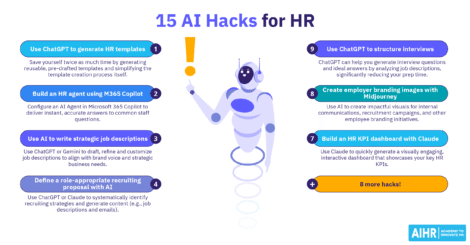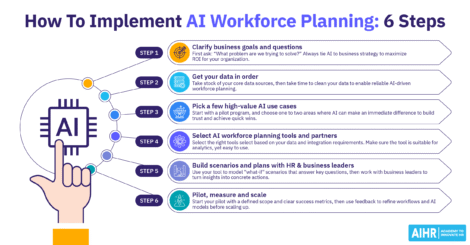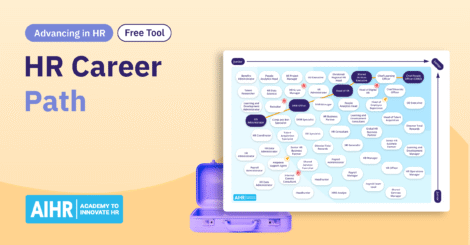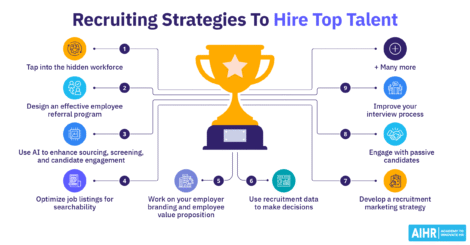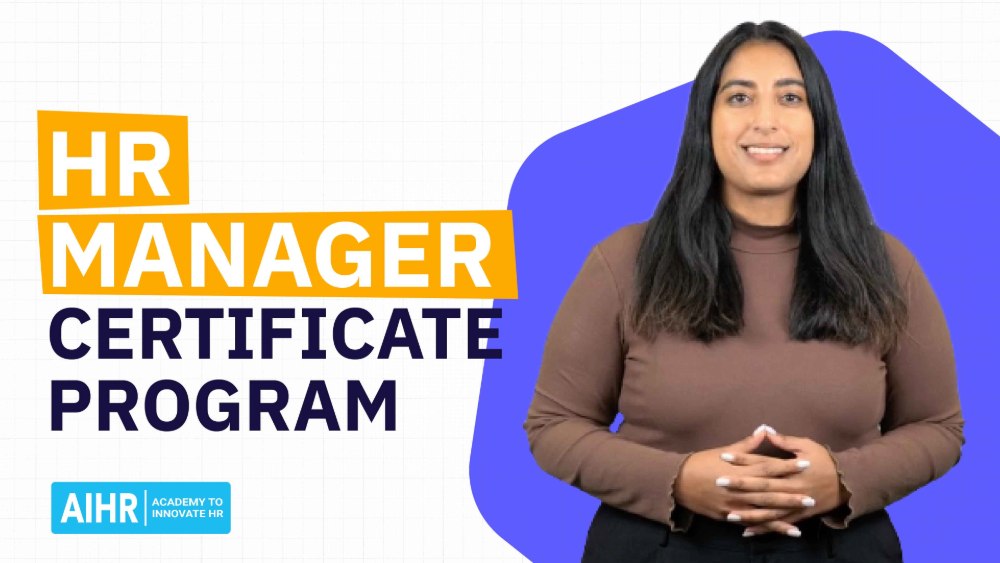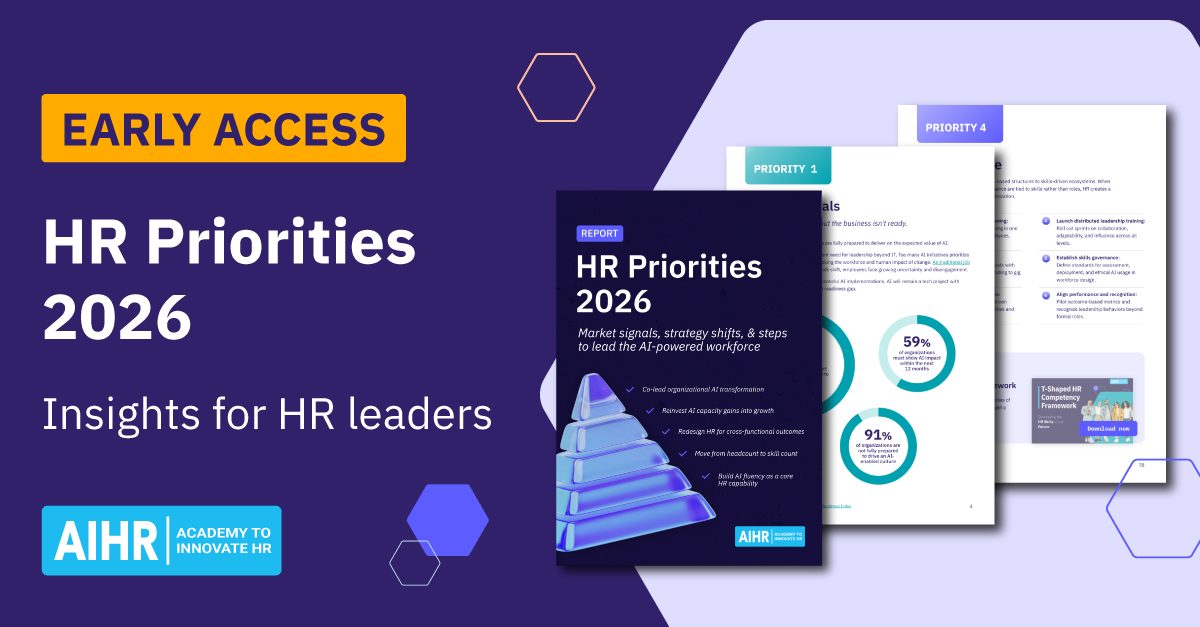AI is not just another tech upgrade. It’s a game-changer, poised to automate half of today’s work activities in the decades ahead. HR teams that act now can gain a competitive advantage. Automating repetitive work boosts efficiency, cuts costs, and frees your team to focus on what matters most.
However, the real win comes from embedding AI across the HR function. This includes blending smart tech with human insight to better manage talent, strengthen culture, and boost productivity. This article looks at how HR leaders can prepare their teams for the future of AI in HR, from building AI readiness and implementing innovative technologies to focusing on uniquely human skills and ethical decision-making.
Contents
Build AI readiness in HR teams
Implement emerging technologies in HR
Shape organizational AI transformation
Strengthen HR’s uniquely human skills
Ensure human oversight and ethics in AI-driven decisions
FAQ
Key takeaways
- HR leaders must prepare their teams for the future of work by building AI readiness across five pillars: culture, governance, technology, competencies, and clear, measurable goals.
- Implementing emerging technologies, such as agentic AI, conversational tools, and voice AI, will be key to evolving core HR processes.
- To lead AI transformation across the business, HR must align its strategy with broader organizational goals and partner closely with other functions.
- Protecting human judgment, ethics, and trust will be HR’s central responsibility as AI becomes more embedded in decision-making.
Here are five things HR leaders can do to set up their team for success in the future.
Build AI readiness in HR teams
Many teams believe that simply implementing AI tools makes them AI-ready. However, being truly prepared for the future of AI in HR means building the right skills, structures, and decision-making capabilities to use those tools effectively and responsibly.
A solid framework can guide that process by offering structure, a shared language, and alignment with broader business goals. Use AIHR’s five-pillar AI Strategy Framework for HR Leaders to align your HR function to broader business goals for your rollout.

Pillar 1: Culture
AI adoption starts with mindset. HR leaders must help teams see AI as a support tool, not a threat. Create space for learning, experimentation, and curiosity, without fear of failure. Make the shift clear: AI is here to reduce repetitive work, not replace people. When teams feel safe and informed, they’re more likely to engage and innovate.
Pillar 2: Governance
Strong governance builds trust in how AI is used. Go beyond compliance. You need to define clear policies, assign accountability, and put processes in place to review risks and bias. Audit AI outcomes regularly. Make sure your tools meet ethical standards and align with business goals, not just technical ones.
Pillar 3: Technology
Start by solving real problems. Focus on use cases that matter, like cutting time to hire or improving engagement. Review your current systems and choose AI that fits your stack. Avoid data silos and disconnected tools. Be sure to also prioritize integration, scalability, and simplicity to keep workflows smooth and ROI high.
Pillar 4: Competencies
Your team needs the right skills to work with AI productively and correctly. Identify current gaps (such as data literacy or prompt design) and offer targeted, hands-on training. It also helps to tie learning to daily tasks — when training feels practical and role-specific, your team’s confidence will grow and adoption will stick.
Pillar 5: Goals
Set clear, measurable goals tied to your HR strategy. Quarterly OKRs work better than broad annual targets because they help keep progress visible and teams agile. At the same time, each AI project should be aligned with a business outcome. This helps you secure buy-in, focus resources, and deliver results fast.
Explore emerging technologies in HR
The next phase of AI in Human Resources goes beyond simple automation. It involves cutting-edge technologies that enable dynamic, human-like interactions. Here are three emerging trends HR leaders must understand to stay ahead of the curve and get ready for the future of AI in HR:
1. Agentic AI
Agentic AI can handle entire workflows — from sourcing candidates to scheduling interviews — without human input. Until now, it’s been deployed mostly in customer service, sales, and IT. However, 40% of companies are currently using or plan to use AI agents within the next six months to streamline HR processes.
For example, companies already use recruiting AI agents in various industries, including retail, technology, and healthcare, to autonomously source candidates based on specific qualifications. Employers also use them in candidate outreach, to schedule interviews, and to assess candidates.
Agentic AI can also aid in predictive workforce planning, staffing strategies, and sentiment analysis, which has helped a major retailer lower staff attrition by 10%. Still, it’s complex and costly to implement, demanding robust data and systems integration and close governance oversight to ensure fair autonomous AI decisions.
2. Conversational AI
Conversational AI enables human-like interactions through text or speech, powering chatbots and virtual assistants to provide instant, accurate responses. In HR, such chatbots can answer questions 24/7. They can support candidates during the hiring process and help employees with tasks like onboarding or HR inquiries.
Walmart’s staff chatbot (available in 44 languages) uses conversational AI to manage 900,000 weekly users and over three million queries per day, reducing time spent planning shifts from 90 minutes to just 30 minutes.
However, the effectiveness of conversational AI depends heavily on the quality of its training data. Setup can be complex, and there is always a risk of providing inaccurate information if the system is not maintained properly.
3. AI voice technology
Voice tools analyze tone, speech, and sentiment to screen candidates or run surveys. For instance, a voice AI tool could conduct initial candidate screenings over the phone, asking a structured set of questions and analyzing the candidate’s responses for key skills. It can then provide recruiters with a summary of the call.
Unilever uses AI to analyze video interviews, scan candidates’ facial expressions, body language, and word choice, and check them against traits considered predictive of job success. This has helped the organization save approximately $1.35 million and over 100,000 hours of human recruitment time annually.
While it’s effective at scale, the technology can be difficult to set up and integrate with existing systems. It’s also critical to manage data privacy and bias carefully, especially with voice recognition and cultural nuances.
To ensure your team is ready for the future of AI in HR, you must equip them with the right mindset, skills, tools, and ethical safeguards to confidently integrate AI into everyday HR work.
With AIHR’s AI for HR Boot Camp, your team will:
✅ Understand appropriate use, ethical boundaries, bias, data security, and privacy risks
✅ Build AI fluency in order to work smarter, faster, and more creatively
✅ Take a structured approach to change and transform the HR function with AI
🎯 Shape the future of HR with a team that understands how to apply AI with purpose.
Shape organizational AI transformation
HR leaders aren’t just responsible for implementing AI in their own function. They are uniquely positioned to plan and spearhead change management initiatives linked to AI rollouts across the organization by aligning talent strategy with technology, leading change, and embedding responsible AI practices across teams.
Here’s what to keep in mind:
Be a change champion
AI can feel intimidating to your HR team and the company’s employees; your role is to minimize this. Ease the transition with clear communication, pilot projects, and success stories that show real impact. Start small (e.g., using AI to automate résumé-screening) and build trust by showing how AI supports the team, as opposed to replacing it.
Build a digital culture
Make AI feel accessible, so employees see AI as a tool, not a threat. Organize simple workshops, recognize early adopters, and encourage feedback from all levels of the company. A culture that welcomes learning and experimentation will adapt to AI faster and with more enthusiasm.
Collaborate with IT and Legal
Smooth rollouts need cross-functional support. Align with IT to ensure integrations work, and bring Legal in early to manage data privacy and compliance. For example, if using AI for talent analytics, include consent on data processing to ensure compliance with regulations like GDPR or CCPA. Regular check-ins also keep teams aligned and minimize risks.
Redefine roles and career paths
AI will inevitably change jobs across HR. In fact, it could automate 30% of current hours worked across different occupations by 2030. Update role descriptions to reflect new responsibilities (e.g., managing AI tools or interpreting data insights), and create clear development paths and upskilling plans to support staff as their roles evolve.
Personalize with data
You can use AI to recommend learning paths, identify potential, or flag disengagement. However, be sure to always combine this with human oversight to maintain fairness and provide sufficient support. Avoid surveillance and instead, use data to offer meaningful opportunities that align with individual goals and growth.
Strengthen HR’s uniquely human skills
As AI takes on more operational and analytical tasks, human qualities like empathy, ethical judgment, and nuanced decision-making will become even more important. Investing in these capabilities now is essential to creating a people-first culture and a successful future of AI in HR that balances innovation with trust and care.
Focus on soft skills and culture
AI automates repetitive and time-consuming tasks such as résumé-screening, scheduling interviews, and managing payroll. HR teams can then focus on coaching, culture, and employee support – areas where human skills matter most. Freeing up this time also strengthens your ability to build trust and respond to real employee needs.
Maintain human judgment
While AI can assess data and generate insights with unmatched speed and precision, human judgment remains indispensable for critical decisions like hiring, development, and terminations. Similarly, AI can track performance data, but HR practitioners must apply empathy and context to make fair, ethical workforce decisions.
Adopt blended workflows
The most effective approach in business today involves a blended workflow of AI and human collaboration. For instance, an AI tool can analyze employee sentiment data from surveys to identify patterns, but an HRBP must use these insights to discern how to engage employees to understand nuances and develop human-centric solutions.
Lead with empathy
As HR becomes increasingly data-driven, empathy must remain a core HR value. Your goal should always be to use data to better understand and support people, not to depersonalize your workplace. Balance tech with humanity at every step, so HR can lead the way in making AI a tool for inclusion, trust, and resilience.

Ensure human oversight and ethics in AI-driven decisions
Without human oversight, AI can amplify biases, leading to eroded trust and affecting employer reputation. As an HR leader, your role is to ensure fairness and accountability in the use of AI, now and in the future. Here’s how you can achieve this:
Establish transparency
Employees deserve to know when AI is involved. If you use AI to screen résumés, for instance, explain in plain language the criteria and process in place (e.g., “Our tool prioritizes role-related skills and experience, but a human always reviews the final candidates before making a hiring decision.” Transparency builds trust and helps demystify new tools.
Tackle bias
AI can inherit biases from data, such as favoring candidates from specific demographics if trained on historically narrow hiring patterns. Combat this through regular audits and diverse datasets to help catch patterns that could lead to unfair outcomes. When something feels off (e.g., one group being selected more often), investigate before scaling further.
Maintain an ethical compass
Create an AI ethics policy outlining fairness, transparency, and accountability. At the same time, train your team to spot ethical concerns (e.g., over-reliance on AI predictions) and empower them to challenge decisions when necessary. Policies are only useful if everyone understands them, so make sure yours are practical and visible.
Apply ethical principles
When selecting tools, choose vendors with use cases proven to demonstrate fairness and explainability in their AI. Test these tools in low-risk areas first, then monitor the results as you scale to more critical decisions. Responsible tool selection saves you the time, effort, and money you’d need to change tools often, and is key to long-term success and credibility.
Keep up-to-date with AI regulations
The EU AI Act, which is being rolled out in phases from 2024 to 2026, emphasizes risk-based oversight, transparency, and human accountability — principles likely to influence the U.S. HR practices. For example, the EU AI Act will require employers to disclose AI use in hiring by 2026. Stay informed by attending industry webinars and consulting with legal.
Final thoughts
The future of AI in HR involves a strategic partnership between human and artificial intelligence. AI will continue automating and optimizing administrative tasks and workflows, freeing your team up to focus on higher-value activities that require uniquely human values and skills like empathy, critical thinking, and discernment.
As such, a balanced approach to AI adoption can transform your HR function into a more optimized, human-centered function. Ultimately, your successful integration of AI won’t be measured by efficiency gains alone but by how effectively you use it to amplify HR in building a positive, productive, and resilient workforce.
FAQ
AI currently helps automate and optimize administrative tasks, but it will become more sophisticated in its ability to manage more complex workflows. This will allow HR professionals to spend more time on higher-value activities that rely on uniquely human skills. Ultimately, this will transform the HR function from an admin-heavy role to a human-centered business partner that drives greater organizational value.
The ‘best’ AI tool for HR depends on your organization’s specific needs. As HR is a multifaceted function, rather than focus on a single software solution, many HR leaders consider a suite of AI tools to meet objectives across areas like recruiting, training and development, leadership development, and payroll.










